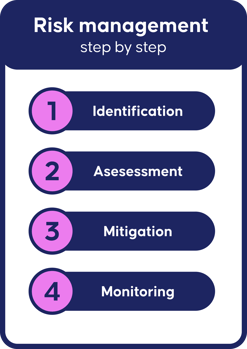Take the test and find out!

Tax Risk Management in multinational corporations
Taxes move fast these days—rules change, filing formats go digital, and penalties get bigger. Tax Risk Management is the simple idea of spotting tax problems early, fixing them quickly, and keeping every deadline under control so the business stays out of trouble. In this article, we break down what Tax Risk Management means in practice and why it’s now the backbone of strong global tax governance for multinational companies.
What is tax risk management?
Tax Risk Management is the systematic discipline of identifying, analysing, mitigating and continuously reviewing every uncertainty that can affect an organisation’s tax position. From looming legislative changes to the simple risk of a missed filing date. Tax risk management draws together people, processes and technology so that a company not only remains compliant but also turns tax into a strategic advantage. In an era of instantaneous reporting obligations, public country-by-country disclosures, and an accelerating push toward digital tax administration. Effective tax risk management has become the cornerstone of global tax governance rather than a narrow compliance exercise.
Why tax risk management matters more than ever
- Rules change fast
Tax rules no longer wait for year-end updates, they drop-in real time. One week a country launches mandatory digital tax reporting or e-invoicing, the next it rolls out a brand-new top-up levy. If your team still trades giant spreadsheets over email, catching every change is like playing whack-a-mole. - Everyone is watching
Investors want proof you pay taxes where you earn profits, customers prefer brands that “play fair,” and potential employees weigh a company’s tax stance when choosing where to work. When you can point to a clear tax data management process and share numbers with confidence, you turn transparency into a competitive edge. - Data Complexity
A multinational might run five ERP systems, dozens of local accounting tools and countless spreadsheets. Important figures hide in those silos, and one mistyped cell can snowball into a huge assessment. Pulling everything into a single, cloud-native tax compliance software workspace replaces detective work with instant clarity: anomalies pop out, reconciliations run automatically, and the tax team spots issues before they become crises—critical for airtight Tax Risk Management. - Teams are stretched
Budgets tighten even as filing calendars grow. Tax departments must cover more countries with fewer people than last year. By automating routine checks, scheduling smart reminders and logging approvals in real time, tax compliance automation frees specialists to focus on high-value planning and controversy work. The result is a smoother, repeatable flow that elevates both efficiency and global tax governance without burning out staff. - Reputation is fragile
One headline about under-paid tax can erase years of brand building overnight. With a robust Tax Risk Management framework—complete with immutable audit trails and real-time dashboards—you can show regulators, auditors and the public exactly how each return was prepared and approved. Fewer surprises, calmer audits and a trusted brand image follow, proving that forward-looking global tax compliance is as much about protecting reputation as avoiding fines.
The step by step of Tax Risk Management
Identification – gather every return, payment and rule that could trip the company up, so nothing slips through the cracks.
Assessment – rank each item by how likely it is to go wrong and how much damage it could cause—from surprise cash payments to reputational hits—so managers know their true priorities.
Mitigation – build controls, checklists and approvals (often in a cloud platform like Keeyns) that lock deadlines, data and responsibilities into place once the hotspots are mapped.
Monitoring – track live dashboards, test controls and update the playbook whenever laws or business models change, turning routine compliance into proactive insight and anchoring strong global tax governance
Efficient reporting and documentation with AI
Scattered files and email threads lead to version mix-ups, missed deadlines and zero visibility into overall risk. That chaos eats up hours, invites penalties and makes it hard to brief the board with confidence. To shift from firefighting to smart, forward-looking tax planning, you need one automated workspace— not another Excel tab.

The tax landscape is only getting faster
International tax rules are tightening at high speed. Governments want more data, delivered sooner, and they’re raising fines for any slip-ups. Fresh demands —like wider e-invoicing mandates in Latin America, or new carbon-border taxes— will all require companies to show, almost in real time, that their tax processes are solid.
Future-Proofing Your Team
That’s why moving to a cloud workspace such as Keeyns is much more than a tech refresh. When every data point, task and sign-off sits in one secure place, tax leaders can respond to auditors quickly, support big deals with up-to-date numbers and prove to investors that the company handles tax responsibly. Good Tax Risk Management then shifts from “just hit the deadline” to powering smarter decisions across the whole business—giving any growth-minded organisation the safest path through tomorrow’s shifting tax landscape.
Disclaimer:
Please remember Keeyns' articles are for informational and educational purposes only. Not for specific tax or legal advice. Always consult a qualified advisor before taking any actions based on this information.
